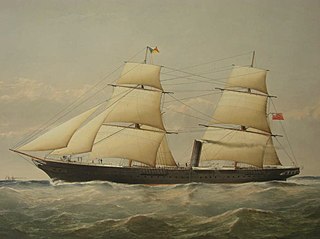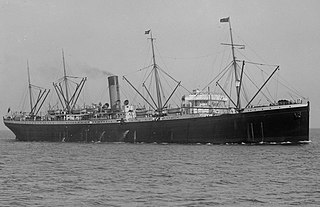
HMHSBritannic was the third and final vessel of the White Star Line's Olympic class of steamships and the second White Star ship to bear the name Britannic. She was the youngest sister of the RMS Olympic and the RMS Titanic and was intended to enter service as a transatlantic passenger liner. She was operated as a hospital ship from 1915 until her sinking near the Greek island of Kea, in the Aegean Sea, in November 1916. At the time she was the largest hospital ship in the world.

SS Carnatic was a British steamship built in 1862-63 by Samuda Brothers at Cubitt Town on the Isle of Dogs, London, for the Peninsular and Oriental Steam Navigation Company (P&O). She operated on the Suez to Bombay run in the last years before the Suez Canal was opened. This route gave a fast, steamship-operated route from Britain to India, connecting with similar steamships running through the Mediterranean to Alexandria, with an overland crossing to Suez. The alternative was to sail round the Cape of Good Hope, a distance at which steam ships were not, in the early 1860s, sufficiently economical to be commercially competitive with sail.

SS Ceramic was an ocean liner built in Belfast for White Star Line in 1912–13 and operated on the Liverpool – Australia route. Ceramic was the largest ship serving the route until P&O introduced RMS Mooltan in 1923.

The SS English Trader was a British merchant ship wrecked off the coast of Norfolk, England in October 1941. After falling behind a convoy during the Second World War of which she was a part, the ship ran aground on the Hammond's Knoll sandbank and began to break up during a gale. Several rescue attempts by lifeboats failed, but a further attempt the following day by the Cromer Lifeboat rescued 44 of the crew, three having already been lost.

The SS Mount Ida was a cargo ship built in 1938 by William Hamilton & Co. Ltd of Glasgow. Launched in 1938 as Arcscott, she was renamed Mount Ida after being bought by the Atlanticos Steam Ship Company Ltd, of Athens, Greece. She was wrecked in 1939 after being in service for only about 18 months.

The Olympic-class ocean liners were a trio of British ocean liners built by the Harland & Wolff shipyard for the White Star Line during the early 20th century. They were Olympic (1911), Titanic (1912) and Britannic (1914). All three were designed to be the largest and most luxurious passenger ships at that time, designed to give White Star an advantage in the transatlantic passenger trade.

SS Suevic was a steamship built by Harland and Wolff in Belfast for the White Star Line. Suevic was the fifth and last of the Jubilee-class ocean liners, built specifically to service the Liverpool-Cape Town-Sydney route, along with her sister ship Runic. In 1907 she was wrecked off the south coast of England, but in the largest rescue of its kind, all passengers and crew were saved. The ship herself was deliberately broken in two, and a new bow was attached to the salvaged stern portion. Later serving as a Norwegian whaling factory ship carrying the name Skytteren, she was scuttled off the Swedish coast in 1942 to prevent her capture by ships of Nazi Germany.

HMHS Rewa was a steamship originally built for the British-India Steam Navigation Company for their mail and passenger service but requisitioned in August 1914 and fitted out for use as a British hospital ship during the First World War. On 4 January 1918, she was hit and sunk by a torpedo from the German U-boat U-55.

HMHS Glenart Castle was a steamship originally built as Galician in 1900 for the Union-Castle Line. She was renamed Glenart Castle in 1914, but was requisitioned for use as a British hospital ship during the First World War. On 26 February 1918, she was hit and sunk by a torpedo fired from the German U-boat UC-56.

SS Monte Nevoso was a cargo steamship that was launched in 1920 in England, owned in Italy, and wrecked in 1932 in the North Sea off the coast of Norfolk.
SS Gallois was a French collier built in 1917 as Tynemouth and later Lord Aberconway. She was one of seven merchant vessels which became stranded and then wrecked on Haisbro Sands off the Norfolk coast on 6 August 1941 during the Second World War as part of Convoy FS 559.
SS Devanha was a passenger liner and cargo vessel operated by the Peninsular and Oriental Steam Navigation Company.
Takliwa was a 7,936 GRT cargo liner that was built in 1924 by Barclay, Curle & Co Ltd, Glasgow, Scotland for the British India Steam Navigation Company. She was converted to a hospital ship during the Second World War, serving until she was wrecked in October 1945.

RNLB Foresters Centenary is a retired Liverpool-class lifeboat of the Royal National Lifeboat Institution (RNLI), stationed in the English coastal town of Sheringham in the county of Norfolk in the United Kingdom. The lifeboat was on station for 25 years between 1936 and 1961 when she was sold. She has been restored to her original condition and is exhibited in Sheringham Museum.
SS Minnewaska was a British ocean liner that was one of the ships that assisted RMS Carpathia with sending out survivors names following the 1912 RMS Titanic disaster. In 1916, she hit a mine laid by SM UC-23 in the Mediterranean Sea 1.5 nautical miles (2.8 km) southeast of Dentero Point, Suda Bay, Crete, while she was travelling from Alexandria, Egypt to Saloniki with 1,600 troops.
SS Stolwijk, a Dutch cargo ship of 2,489 tons, was wrecked off the coast of Donegal on 6 December 1940. She was part of a Convoy SC 13 sailing from the Dominion of Newfoundland to Liverpool, England, when her rudder was damaged in a fierce storm. Attempts to rescue her by her destroyer escort failed and she went on the rocks off Tory Island, County Donegal, Ireland. Ten of her crew were lost but the remaining 18 were rescued the following day by Arranmore Lifeboat and landed safely in Burtonport. The rescue of the survivors was conducted in terrible weather conditions and both the RNLI and Queen Wilhelmina of the Netherlands awarded medals to the Irish lifeboat crew.

Saltwick Bay is a north-east facing bay approximately one mile (1.6 km) to the east of Whitby, on the east coast of North Yorkshire, England. The bay contains the Saltwick Nab alum quarries, listed under the Ancient Monuments and Archaeological Areas Act 1979. The bay is part of the Saltwick Formation and known for its collections of fossils. The SS Rohilla hospital ship sank in the bay in 1914, and the fishing trawler Admiral Van Tromp was shipwrecked there in 1976. The bay is accessible through Whitby Holiday Park.

Scarborough Lifeboat Station is a Royal National Lifeboat Institution (RNLI) operated lifeboat station in Scarborough, North Yorkshire, England. A lifeboat was established at Scarborough in 1801, which makes it the third oldest lifeboat station in the United Kingdom.

Whitby Lifeboat Station is a Royal National Lifeboat Institution (RNLI) lifeboat station located in Whitby, North Yorkshire, England. It is one of nine situated along the Yorkshire coast. Whitby has had a lifeboat station since 1802, with the RNLI responsible since 1861. In its 200 plus year history, Whitby has had five different lifeboat stations. A sixth lifeboat and station was located at Upgang, just up the coast from Whitby, and whilst it was considered separate from Whitby, it was crewed by men from the Whitby lifeboat.


















